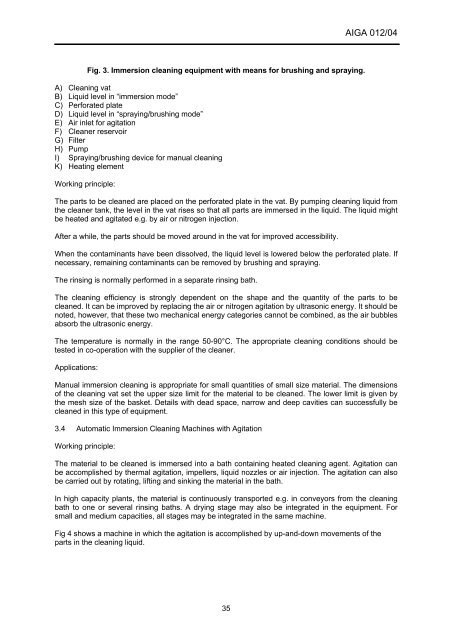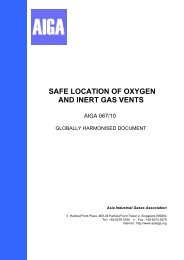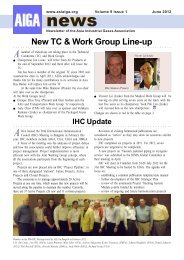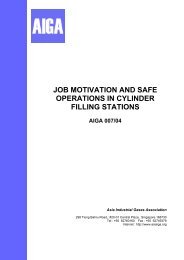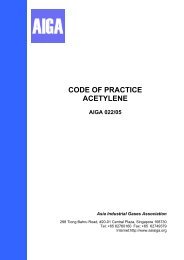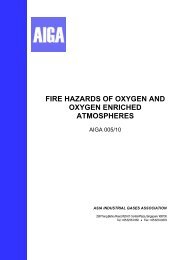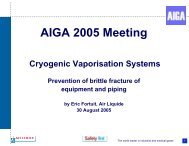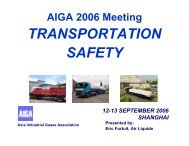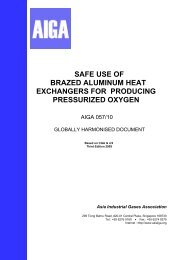CLEANING OF EQUIPMENT FOR OXYGEN SERVICE - AIGA
CLEANING OF EQUIPMENT FOR OXYGEN SERVICE - AIGA
CLEANING OF EQUIPMENT FOR OXYGEN SERVICE - AIGA
Create successful ePaper yourself
Turn your PDF publications into a flip-book with our unique Google optimized e-Paper software.
Fig. 3. Immersion cleaning equipment with means for brushing and spraying.<br />
A) Cleaning vat<br />
B) Liquid level in “immersion mode”<br />
C) Perforated plate<br />
D) Liquid level in “spraying/brushing mode”<br />
E) Air inlet for agitation<br />
F) Cleaner reservoir<br />
G) Filter<br />
H) Pump<br />
I) Spraying/brushing device for manual cleaning<br />
K) Heating element<br />
Working principle:<br />
35<br />
<strong>AIGA</strong> 012/04<br />
The parts to be cleaned are placed on the perforated plate in the vat. By pumping cleaning liquid from<br />
the cleaner tank, the level in the vat rises so that all parts are immersed in the liquid. The liquid might<br />
be heated and agitated e.g. by air or nitrogen injection.<br />
After a while, the parts should be moved around in the vat for improved accessibility.<br />
When the contaminants have been dissolved, the liquid level is lowered below the perforated plate. If<br />
necessary, remaining contaminants can be removed by brushing and spraying.<br />
The rinsing is normally performed in a separate rinsing bath.<br />
The cleaning efficiency is strongly dependent on the shape and the quantity of the parts to be<br />
cleaned. It can be improved by replacing the air or nitrogen agitation by ultrasonic energy. It should be<br />
noted, however, that these two mechanical energy categories cannot be combined, as the air bubbles<br />
absorb the ultrasonic energy.<br />
The temperature is normally in the range 50-90°C. The appropriate cleaning conditions should be<br />
tested in co-operation with the supplier of the cleaner.<br />
Applications:<br />
Manual immersion cleaning is appropriate for small quantities of small size material. The dimensions<br />
of the cleaning vat set the upper size limit for the material to be cleaned. The lower limit is given by<br />
the mesh size of the basket. Details with dead space, narrow and deep cavities can successfully be<br />
cleaned in this type of equipment.<br />
3.4 Automatic Immersion Cleaning Machines with Agitation<br />
Working principle:<br />
The material to be cleaned is immersed into a bath containing heated cleaning agent. Agitation can<br />
be accomplished by thermal agitation, impellers, liquid nozzles or air injection. The agitation can also<br />
be carried out by rotating, lifting and sinking the material in the bath.<br />
In high capacity plants, the material is continuously transported e.g. in conveyors from the cleaning<br />
bath to one or several rinsing baths. A drying stage may also be integrated in the equipment. For<br />
small and medium capacities, all stages may be integrated in the same machine.<br />
Fig 4 shows a machine in which the agitation is accomplished by up-and-down movements of the<br />
parts in the cleaning liquid.


